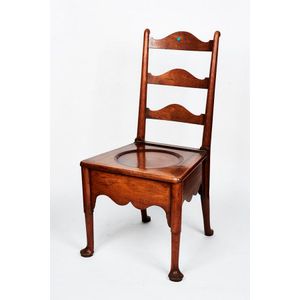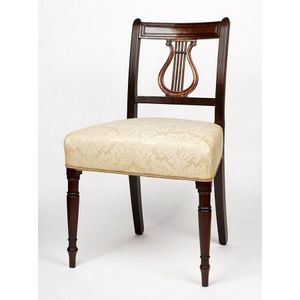George III Mahogany Dining Chairs with Silk Brocade Seats
You must be a subscriber, and be logged in to view price and dealer details.
Subscribe Now to view actual auction price for this item
When you subscribe, you have the option of setting the currency in which to display prices to $Au, $US, $NZ or Stg.
- Turning - Any part of a piece of furniture that has been turned and shaped with chisels on a lathe. Turned sections include legs, columns, feet, finials, pedestals, stretchers, spindles etc. There have been many varieties and fashions over the centuries: baluster, melon, barley-sugar, bobbin, cotton-reel, rope-twist, and so on. Split turning implies a turned section that has been cut in half lengthwise and applied to a cabinet front as a false decorative support.
- Lyre Motif - The lyre motif is an ancient decorative design that is believed to have originated in ancient Greece, where the lyre was a popular musical instrument. The lyre itself was often decorated with ornate carvings and designs, including the iconic lyre motif.
In ancient Greek mythology, the lyre was associated with the god Apollo, who was the patron of music and the arts. The lyre was said to have been invented by the god Hermes, who presented it to Apollo as a gift. As a result, the lyre became a symbol of creativity, inspiration, and artistic expression.
The lyre motif typically features a curved or S-shaped body, with strings extending upwards from the base. The motif was often used in architectural decoration, as well as on pottery, jewellery, and other decorative objects. - George Iii - George III (1738 - 1820) was King of Great Britain and Ireland from 1760 to 1820.
- Lyre - Attributed to the 18th century designer Robert Adam, the back splat of a chair or sthe supports of a table are in the form of a lyre, a Greek musical instrument similar to a harp.
In shape it resembles two reversed scrolls.
Chairs continued to be made in this style for at least the next fifty years.
In Australia many cedar chairs and tables have survived dating to the 1830s and 1840s, featuring the lyre shape in the back splats and as supports for small tables. - Mahogany - Mahogany is a dense, close grained red-coloured timber from the West Indies and Central America. It was first imported into Europe in the the early 18th century and its use continued through the 19th century. It was popular for furniture making because of its strength, the wide boards available, the distinctive grain on some boards, termed flame mahogany and the rich warm colour of the timber when it was polished.. The "flame" was produced where a limb grew out from the trunk of the tree, and this timber was usually sliced into veneers for feature panels on doors, backs and cornices.
Some terms used to describe mahogany relate to the country from which it originally came, such as "Cuban" mahogany, "Honduras" mahogany etc. However unless the wood has been tested the names assigned are more a selling feature, rather than a true indication of the timber's origin.
This item has been included into following indexes:
- chairs, sets of 6, style or period - Georgian 91
-
chairs, sets of 6, timber
- all styles and timbers 747
- mahogany 175
Visually similar items

A pair of Regency period mahogany side chairs early 19th century the chairs are decorated with finely turned front legs, veneered back rails and upholstered drop in seats. Height 86 cm

O. Noel Coulson (1905-1993), arm chair, c. 1958 manufactured by S. Andrewartha furniture, Melbourne, with upholstered back and seat, front legs with brass sabots. Height 85 cm, width 60 cm, depth 52 cm. Provenance: Commissioned for 211 Kooyong Rd, Toorak,

George III Chippendale chair, with a shaped back, above shaped and pierced centre splat, above covered drop in seat, with carved shell apron on hoof feet

Victorian mahogany commode chair, 19th century, with ladder back and shaped apron, height 99 cm
